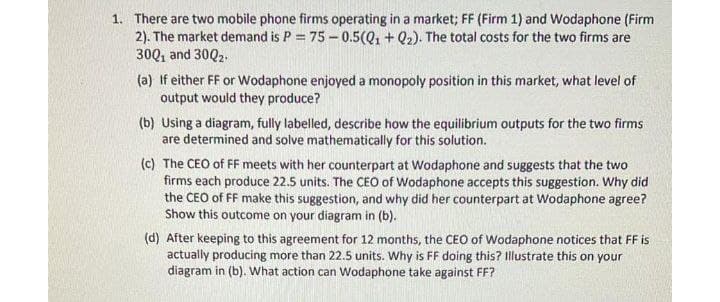1. There are two mobile phone firms operating in a market; FF (Firm 1) and Wodaphone (Firm 2). The market demand is P = 75 -0.5(Q₁ + Q₂). The total costs for the two firms are 300₁ and 30Q₂. (a) If either FF or Wodaphone enjoyed a monopoly position in this market, what level of output would they produce? (b) Using a diagram, fully labelled, describe how the equilibrium outputs for the two firms are determined and solve mathematically for this solution. (c) The CEO of FF meets with her counterpart at Wodaphone and suggests that the two firms each produce 22.5 units. The CEO of Wodaphone accepts this suggestion. Why did the CEO of FF make this suggestion, and why did her counterpart at Wodaphone agree? Show this outcome on your diagram in (b). (d) After keeping to this agreement for 12 months, the CEO of Wodaphone notices that FF is actually producing more than 22.5 units. Why is FF doing this? Illustrate this on your diagram in (b). What action can Wodaphone take against FF?
1. There are two mobile phone firms operating in a market; FF (Firm 1) and Wodaphone (Firm 2). The market demand is P = 75 -0.5(Q₁ + Q₂). The total costs for the two firms are 300₁ and 30Q₂. (a) If either FF or Wodaphone enjoyed a monopoly position in this market, what level of output would they produce? (b) Using a diagram, fully labelled, describe how the equilibrium outputs for the two firms are determined and solve mathematically for this solution. (c) The CEO of FF meets with her counterpart at Wodaphone and suggests that the two firms each produce 22.5 units. The CEO of Wodaphone accepts this suggestion. Why did the CEO of FF make this suggestion, and why did her counterpart at Wodaphone agree? Show this outcome on your diagram in (b). (d) After keeping to this agreement for 12 months, the CEO of Wodaphone notices that FF is actually producing more than 22.5 units. Why is FF doing this? Illustrate this on your diagram in (b). What action can Wodaphone take against FF?
Chapter14: Monopoly
Section: Chapter Questions
Problem 14.10P
Related questions
Question
solve

Transcribed Image Text:1. There are two mobile phone firms operating in a market; FF (Firm 1) and Wodaphone (Firm
2). The market demand is P = 75 – 0.5(Q1 + Q2). The total costs for the two firms are
30Q, and 30Q2.
(a) If either FF or Wodaphone enjoyed a monopoly position in this market, what level of
output would they produce?
(b) Using a diagram, fully labelled, describe how the equilibrium outputs for the two firms
are determined and solve mathematically for this solution.
(c) The CEO of FF meets with her counterpart at Wodaphone and suggests that the two
firms each produce 22.5 units. The CEO of Wodaphone accepts this suggestion. Why did
the CEO of FF make this suggestion, and why did her counterpart at Wodaphone agree?
Show this outcome on your diagram in (b).
(d) After keeping to this agreement for 12 months, the CEO of Wodaphone notices that FF is
actually producing more than 22.5 units. Why is FF doing this? Illustrate this on your
diagram in (b). What action can Wodaphone take against FF?
Expert Solution
This question has been solved!
Explore an expertly crafted, step-by-step solution for a thorough understanding of key concepts.
Step by step
Solved in 5 steps with 4 images

Knowledge Booster
Learn more about
Need a deep-dive on the concept behind this application? Look no further. Learn more about this topic, economics and related others by exploring similar questions and additional content below.Recommended textbooks for you


Managerial Economics: A Problem Solving Approach
Economics
ISBN:
9781337106665
Author:
Luke M. Froeb, Brian T. McCann, Michael R. Ward, Mike Shor
Publisher:
Cengage Learning

Managerial Economics: Applications, Strategies an…
Economics
ISBN:
9781305506381
Author:
James R. McGuigan, R. Charles Moyer, Frederick H.deB. Harris
Publisher:
Cengage Learning


Managerial Economics: A Problem Solving Approach
Economics
ISBN:
9781337106665
Author:
Luke M. Froeb, Brian T. McCann, Michael R. Ward, Mike Shor
Publisher:
Cengage Learning

Managerial Economics: Applications, Strategies an…
Economics
ISBN:
9781305506381
Author:
James R. McGuigan, R. Charles Moyer, Frederick H.deB. Harris
Publisher:
Cengage Learning